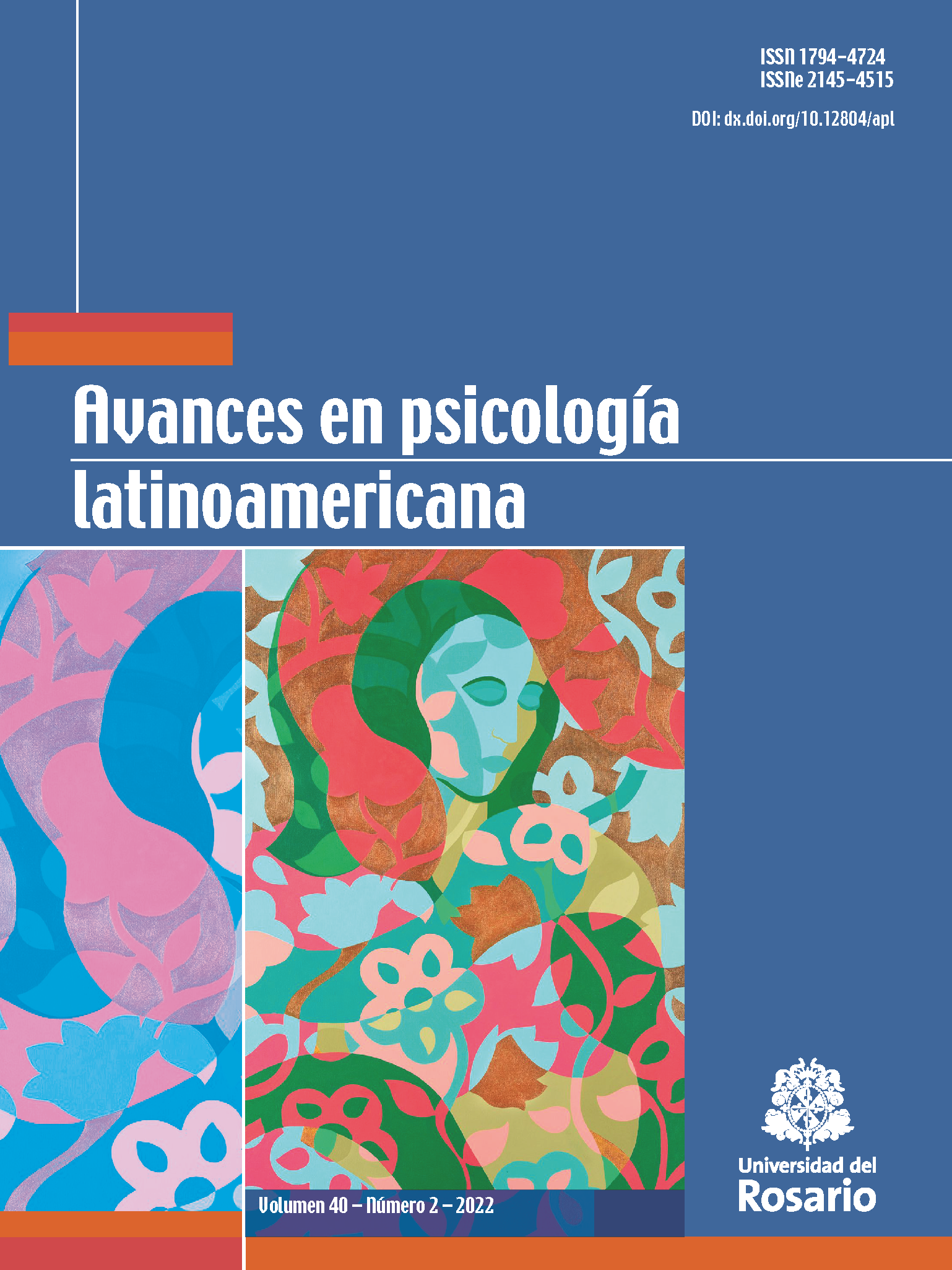El papel predictivo del IMC, la edad, los ingresos económicos, la salud mental, la personalidad y la internalización de patrones de apariencia sobre la insatisfacción corporal en adultos hombres y mujeres
Barra lateral del artículo
Contenido principal del artículo
Este artículo presenta los resultados de la investigación del papel predictivo del índice de masa corporal (IMC), la edad, la internalización de los patrones de apariencia, los rasgos de personalidad, la salud mental y los ingresos económicos en la insatisfacción corporal en adultos. En el estudio participaron 156 (28.5 %) hombres y 391 (71.5 %) mujeres (M edad = 28.9). Todos respondieron un cuestionario sociodemográfico, el Inventario de Salud Mental (MHI5), los Marcadores Reducidos de Personalidad, el Cuestionario de Actitudes Socioculturales con Respecto a la Apariencia (SATAQ-3) y la Escala Situacional de Satisfacción Corporal (ESSC). Se realizaron análisis de regresión lineal múltiple. Para insatisfacción y gordura, los predictores significativos para las mujeres fueron el IMC (β = 0.52), la internalización (β = 0.45), el neuroticismo (β = 0.12) y la salud mental (β = - 0.13), mientras que para los hombres fueron el IMC (β = 0.59) y la internalización (β = 0.38). […] Los resultados identifican diferencias entre hombres y mujeres, y múltiples variables que influyen en la insatisfacción corporal.
Descargas
Albert, P. R. (2015). Why is depression more prevalent in women? Journal of Psychiatry & Neuroscience: jpn, 40(4), 219–221. https://doi.org/10.1503/jpn.150205
Allen, M. S., & Robson, D. A. (2020). Personality and body dissatisfaction: An updated systematic review with meta-analysis. Body Image, 33, 77–89. https://doi.org/https://doi.org/10.1016/j.bodyim.2020.02.001
Allen, M. C., & Walter, E. E. (2016). Personality and body image: A systematic review. Body Image, 19, 79–88. https://doi.org/10.1016/j.bodyim.2016.08.012
Alleva, J. M., Sheeran, P., Webb, T. L., Martijn, C., & Miles, E. (2015). A meta-analytic review of stand-alone interventions to improve body image. PLoS one, 10(9), Article e0139177. https://doi.org/10.1371/journal.pone.0139177
Amaral, A. C., Ribeiro, M. S., Conti, M. A., Ferreira, C. S., & Ferreira, M. E. (2013). Psychometric evaluation of the Sociocultural Attitudes Towards Appearance Questionnaire-3 among Brazilian young adults. The Spanish Journal of Psychology, 16, Article E94. https://doi.org/10.1017/sjp.2013.94
American Psychiatric Association (APA). (2013). Diagnostic and statistical manual of mental disorders: DSM-5. American Psychiatric Association. http://dx.doi.org/10.1176/appi.books.9780890425596
Andrew, R., Tiggemann, M., & Clark, L. (2016). Predicting body appreciation in young women: An integrated model of positive body image. Body Image, 18, 34–42. https://doi.org/10.1016/j.bodyim.2016.04.003
Barlow, D. H., Ellard, K. K., Sauer-Zavala, S., Bullis, J. R., & Carl, J. R. (2014). The origins of neuroticism. Perspectives on Psychological Science, 9(5), 481–496. https://doi.org/10.1177/1745691614544528
Cafri, G., Yamamiya, Y., Brannick, M. T., & Thompson, J. K. (2005). The influence of sociocultural factors on body image: A meta-analysis. Clinical Psychology: Science and Practice, 12(4), 421– 433. https://doi.org/10.1093/clipsy/bpi053
Cash, T. F. (2011). Cognitive-behavioral perspectives on body image. In T. F. Cash & L. Smolak (Eds.), Body image: A handbook of science, practice, and prevention (pp. 39–47). The Guilford Press.
Czyz, S. H., Swanepoel, M., Moss, S. J., & Monyeki, M. A. (2016). Relationship between body image and socio-economic status in South African adolescents: PAHL-study. South African Journal for Research in Sport, Physical Education and Recreation, 38(1), 31–42. https://hdl.handle.net/10520/EJC186989
Damásio, B. F., Borsa, J. C., & Koller, S. H. (2014). Adaptation and psychometric properties of the Brazilian version of the Five-item Mental Health Index (MHI-5). Psicologia: Reflexão e Crítica, 27(2), 323-330. https://doi.org/10.1590/1678-7153.201427213
Dion, J., Hains, J., Vachon, P., Plouffe, J., Laberge, L., Perron, M., McDuff, P., Kalinova, E., & Leone, M. (2016). Correlates of body dissatisfaction in children. Journal of Pediatrics, 171, 202–207. https://doi.org/10.1016/j.jpeds.2015.12.045
Field, A. P. (2013). Discovering statistics using IBM SPSS statistics: And sex and drugs and rock ‘n’ roll (4th ed). Sage.
Forbush, K. T., Siew, C. S., & Vitevitch, M. S. (2016). Application of network analysis to identify interactive systems of eating disorder psychopathology. Psychological Medicine, 46(12), 2667–2677. https://doi.org/10.1017/S003329171600012X
Goldschmidt, A. B., Wall, M., Choo, T. H., Becker, C., & Neumark-Sztainer, D. (2016). Shared risk factors for mood-, eating-, and weight-related health outcomes. Health Psychology: Official Journal of the Division of Health Psychology, American Psychological Association, 35(3), 245–252. https://doi.org/10.1037/hea0000283
Grogan, S. (2016). Understanding body dissatisfaction in men, women and children (3rd ed.). Routledge. https://doi.org/10.4324/9781315681528
Hauck Filho, N., Machado, W. D. L., Teixeira, M. A. P., & Bandeira, D. R. (2012). Evidências de validade de marcadores reduzidos para a avaliação da personalidade no modelo dos cinco grandes fatores. Psicologia: Teoria e Pesquisa, 28, 417–423. https://dx.doi.org/10.1590/S0102-3772201200040000
Hirata, E., & Pilati, R. (2010). Desenvolvimento e validação preliminar da Escala Situacional de Satisfação Corporal - essc. Psico-USF, 15(1), 1–11. https://dx.doi.org/10.1590/S1413-82712010000100002
Jeronimus, B. F., Riese, H., Sanderman, R., & Ormel, J. (2014). Mutual reinforcement between neuroticism and life experiences: A five-wave, 16-year study to test reciprocal causation. Journal of Personality and Social Psychology, 107(4), 751–764. http://dx.doi-org.ez29.capes.proxy.ufrj.br/10.1037/a0037009
John, O. P., Robins, R., & Pervin, L. A. (2008). Handbook of personality: Theory and research (3rd ed.). Guilford Press.
Karazsia, B. T., Murnen, S. K., & Tylka, T. L. (2017). Is body dissatisfaction changing across time? A cross-temporal meta-analysis. Psychological Bulletin, 143(3), 293–320. https://doi.org/10.1037/bul0000081
Laus, M. F., Kakeshita, I. S., Costa, T. M. B., Ferreira, M. E. C., Fortes, L. de S., & Almeida, S. S. (2014). Body image in Brazil: Recent advances in the state of knowledge and methodological issues. Revista de Saude Publica, 48(2), 331–346. https://doi.org/10.1590/S0034-8910.2014048004950
McLean, C. P., Asnaani, A., Litz, B. T., & Hofmann, S. G. (2011). Gender differences in anxiety disorders: Prevalence, course of illness, comorbidity and burden of illness. Journal of Psychiatric Research, 45(8), 1027–1035. https://doi.org/10.1016/j.jpsychires.2011.03.006
Menzel, J. E., Krawczyk, R., & Thompson, J. K. (2011). Attitudinal assessment of body image for adolescents and adults. In T. Cash & L. Smolak (Eds.), Body Image: A handbook of a theory, research and clinical practice (2nd ed.) (pp. 154–172). Guilford.
Mills, J., & Fuller-Tyszkiewicz, M. (2016). Fat talk and body image disturbance: A systematic review and meta-analysis. Psychology of Women Quarterly, 41(1), 114–129. https://doi.org/10.1177/0361684316675317
Morris, M. W., Hong, Y. Y., Chiu, C. Y., & Liu, Z. (2015). Normology: Integrating insights about social norms to understand cultural dynamics. Organizational Behavior and Human Decision Processes, 129, 1-13. https://doi.org/10.1016/j.obhdp.2015.03.001
Paterna, A., Alcaraz-Ibáñez, M., Fuller-Tyszkiewicz, M., & Sicilia, Á. (2021). Internalization of body shape ideals and body dissatisfaction: A systematic review and meta-analysis. International Journal of Eating Disorders, 54(9), 1575–1600. https://doi.org/10.1002/eat.23568
Paans, N. P. G., Bot, M., Brouwer, I. A., Visser, M., & Penninx, B. W. J. H. (2018). Contributions of depression and body mass index to body image. Journal of Psychiatric Research, 103, 18-25. https://doi.org/10.1016/j.jpsychires.2018.05.003
Pawijit, Y., Likhitsuwan, W., Ludington, J., & Pisitsungkagarn, K. (2017). Looks can be deceiving: Body image dissatisfaction relates to social anxiety through fear of negative evaluation. International Journal of Adolescent Medicine and Health, 31(4), 20170031. https://doi.org/10.1515/ijamh-2017-0031
Regis, J. M. O., Ramos-Cerqueira, A. T. A., Lima, M. C. P., & Torres, A. R. (2018). Social anxiety symptoms and body image dissatisfaction in medical students: Prevalence and correlates. Jornal Brasileiro de Psiquiatria, 67(2), 65–73. https://dx.doi.org/10.1590/0047-2085000000187
Rodgers, R. F., O’Flynn, J. L., Bourdeau, A., & Zimmerman, E. (2018). A biopsychosocial model of body image, disordered eating, and breastfeeding among postpartum women. Appetite, 126, 163–168. https://doi.org/10.1016/j.appet.2018.04.007
Rodgers, R. F., Paxton, S. J., & McLean, S. A. (2014). A biopsychosocial model of body image concerns and disordered eating in early adolescent girls. Journal of Youth and Adolescence, 43(5), 814–823. https://doi.org/10.1007/s10964-013-0013-7
Runfola, C. D., Von Holle, A., Trace, S. E., Brownley, K. A., Hofmeier, S. M., Gagne, D. A., & Bulik, C. M. (2013). Body dissatisfaction in women across the lifespan: Results of the UNC-self and gender and body image (GABI) studies. European Eating Disorders Review: The Journal of the Eating Disorders Association, 21(1), 52–59. https://doi.org/10.1002/erv.2201
Scully, M., Swords, L., & Nixon, E. (2020). Social comparisons on social media: Online appearance-related activity and body dissatisfaction in adolescent girls. Irish Journal of Psychological Medicine, 1-12. https://doi.org/10.1017/ipm.2020.93
South, S. C., Jarnecke, A. M., & Vize, C. E. (2018). Sex differences in the Big Five model personality traits: A behavior genetics exploration. Journal of Research in Personality, 74, 158-165. https://doi.org/10.1016/j.jrp.2018.03.002
Steel, P., Schmidt, J., & Shultz, J. (2008). Refining the relationship between personality and subjective well-being. Psychological Bulletin, 134(1), 138–161. https://doi.org/10.1037/0033-
134.1.138
Stevens, S. D., Herbozo, S., Morrell, H. E., Schaefer, L. M., & Thompson, J. K. (2017). Adult and childhood weight influence body image and depression through weight stigmatization. Journal of Health Psychology, 22(8), 1084–1093. https://doi.org/10.1177/1359105315624749
Sutin, A. R., & Terracciano, A. (2016). Five-factor model personality traits and the objective and subjective experience of body weight. Journal of Personality, 84(1), 102–112. https://doi.org/10.1111/jopy.12143
Swami, V. (2015). Cultural influences on body size ideals. European Psychologist, 20, 44-51. https://doi.org/10.1027/1016-9040/a000150
Swami, V., Hadji-Michael, M., & Furnham, A. (2008). Personality and individual difference correlates of positive body image. Body Image, 5(3), 322–325. https://doi.org/https://doi.org/10.1016/j.bodyim.2008.03.007
Swami, V., Frederick, D. A., Aavik, T., Alcalay, L., Allik, J., Anderson, D., & Zivcic-Becirevic, I. (2010). The attractive female body weight and female body dissatisfaction in 26 countries across 10 world regions: Results of the international body project I. Personality & Social Psychology Bulletin, 36(3), 309–325. https://doi.org/10.1177/0146167209359702
Thompson, J. K., Van Den Berg, P., Roehrig, M., Guarda, A. S., & Heinberg, L. J. (2004). The Sociocultural Attitudes Towards Appearance Scale-3 (sataq-3): Development and validation. International Journal of Eating Disorders, 35(3), 293-304. http://dx.doi.org/10.1002/eat.10257
Thompson, J. K., & Stice, E. (2001). Thin-ideal internalization: Mounting evidence for a new risk factor for body-image disturbance and eating pathology. Current Directions in Psychological Science, 10(5), 181–183. https://doi.org/10.1111/1467-8721.00144
Tiggemann, M. (2011). Sociocultural perspectives on human appearance and body image. En T. F. Cash & L. Smolak (Eds.), Body image: A handbook of science, practice, and prevention (pp. 12–19). Guilford Press.
Tiggemann, M., & McCourt, A. (2013). Body appreciation in adult women: Relationships with age and body satisfaction. Body Image, 10(4), 624–627. https://doi.org/10.1016/j.bodyim.2013.07.003
Van Droogenbroeck, F., Spruyt, B., & Keppens, G. (2018). Gender differences in mental health problems among adolescents and the role of social support: Results from the Belgian health interview surveys 2008 and 2013. BMC Psychiatry, 18(1), 6. https://doi.org/10.1186/s12888-018-1591-4
Ware, J. E., Snow, K. K., Kosinski, M., & Gandek, B. (1993). SF-36 Health Survey manual and interpretation guide. The Health Institute; New England Medical Center.
Weinberger, N. A., Kersting, A., Riedel-Heller, S. G., & Luck-Sikorski, C. (2016). Body dissatisfaction in individuals with obesity compared to normal-weight individuals: A systematic review and meta-analysis. Obesity Facts, 9(6), 424–441. https://doi.org/10.1159/000454837
Wichstrøm, L., & Von Soest, T. (2016). Reciprocal relations between body satisfaction and self-esteem: A large 13-year prospective study of adolescents. Journal of Adolescence, 47(7491), 16–27. https://doi.org/10.1016/j.adolescence.2015.12.003
Detalles del artículo

Esta obra está bajo una licencia internacional Creative Commons Atribución-NoComercial-SinDerivadas 4.0.
Los autores conservan los derechos de autor y garantizan a la revista el derecho de ser la primera publicación del trabajo al igual que licenciado bajo una Creative Commons Attribution License que permite a otros compartir el trabajo con un reconocimiento de la autoría del trabajo y la publicación inicial en esta revista.
Artículos más leídos del mismo autor/a
- Fernanda de Oliveira Paveltchuk, Juliane Callegaro Borsa, Homofobia internalizada, conectividad comunitaria y salud mental en una muestra de individuos LGB brasileños , Avances en Psicología Latinoamericana : Vol. 37 Núm. 1 (2019): Avances en Psicología Latinoamericana








